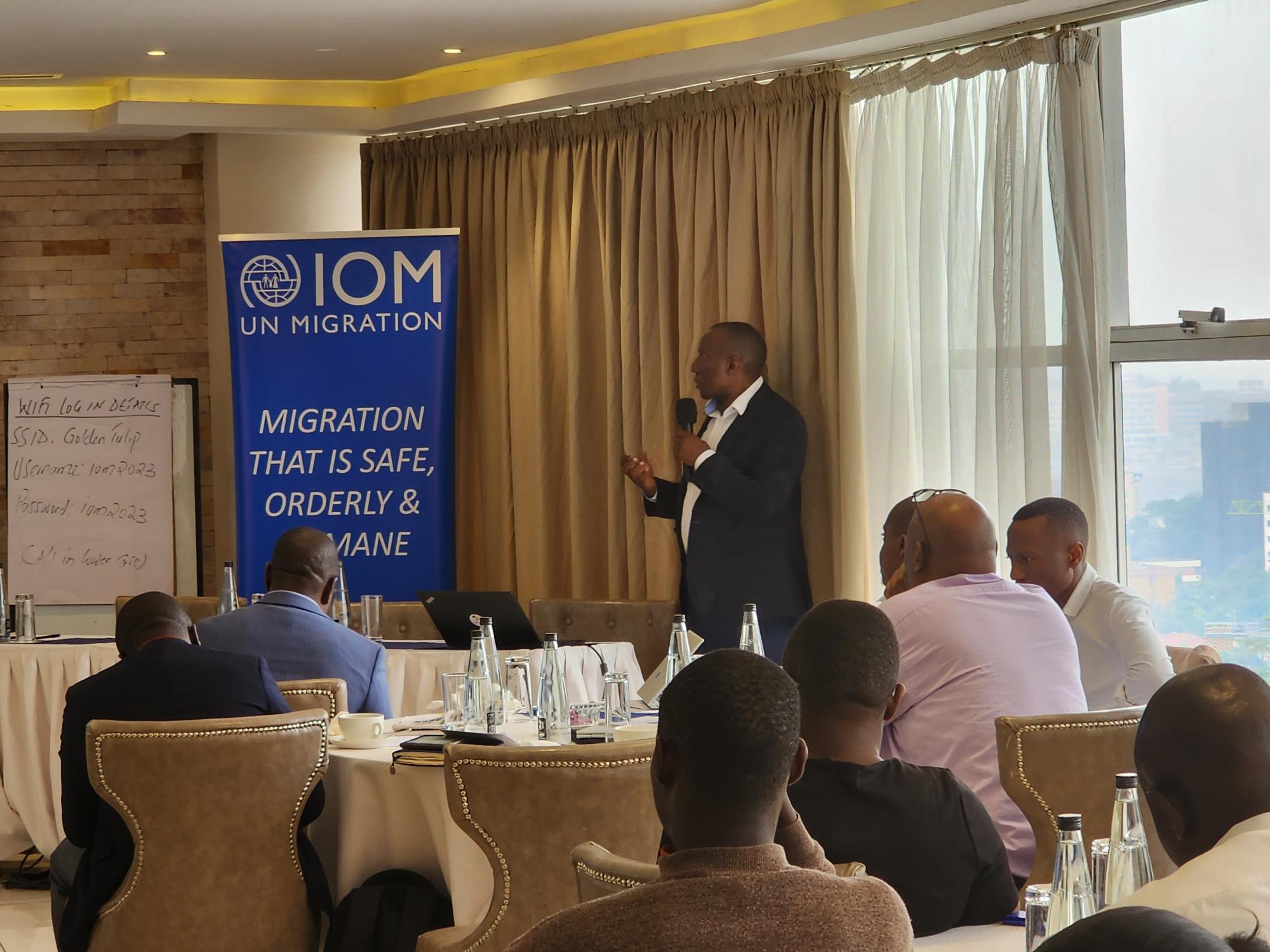-
Who We Are
WHO WE AREThe International Organization for Migration (IOM) is part of the United Nations System as the leading inter-governmental organization promoting since 1951 humane and orderly migration for the benefit of all, with 175 member states and a presence in over 100 countries. IOM has had a presence in Uganda since 1988.
About
About
IOM Global
IOM Global
-
Our Work
Our WorkAs the leading inter-governmental organization promoting since 1951 humane and orderly migration, IOM plays a key role to support the achievement of the 2030 Agenda through different areas of intervention that connect both humanitarian assistance and sustainable development. Across Uganda IOM supports the Government to address migration challenges and build the capacity of relevant stakeholders.
Cross-cutting (Global)
Cross-cutting (Global)
- Data and Resources
- Take Action
- 2030 Agenda
Experts review best practices and lessons learnt from EU funded Disaster Preparedness project
By Abubaker Mayemba
Government officials and humanitarian partners have met to review best practices and lessons learned from IOM’s just-ended project, "Strengthening National and Local Disaster Preparedness and Response Capacities".
Funded by European Union Humanitarian Aid in 20 districts, the project aimed to boost the central and local government capacities in disaster response planning, management and risk reduction. A key pillar of the project was the provision of verifiable data for policy and adaptation in the target districts.
An assessment report by Dr Bernard Barasa revealed that the two-year project had strengthened stakeholder-beneficiary relationships and improved Disaster Risk Reduction (DRR) information management. The project’s other achievements included the standardization of Disaster Rapid Needs Assessment (RNA) tools, the establishment of shelter emergency units, and support for the development of Standard Operating Procedures (SOPS) for the mobile emergency shelter.
Working with the Uganda Red Cross Society (UCRS) as an implementing partner, the project set up and tested an evacuation shelter in Kasese district. To evaluate the effectiveness of Katakwi district’s disaster response plan, a simulation exercise was conducted, with Non-Food items (NFIs) prepositioned to be distributed to vulnerable people in case disasters struck. In addition, the report noted, Ngora and Katakwi districts were able to develop contingency plans, and boost their Disaster Management Committees’ knowledge of preparedness and information management.
“This project has realized the usefulness of functional District and Sub-County Disaster Management Committees (DDMCs and SDMCs) and improved disaster preparedness and response capacities,” Dr Barasa said.
To enhance real-time coordination during emergencies, the project donated audio-visual conferencing equipment to the Department of Relief, Disaster Preparedness and Management in the Office of the Prime Minister (OPM). Further, IOM facilitated discussions to harmonize training documents on DRR into a standardized national training manual. The capacity-building sessions aimed at enabling consistency in disaster data, interoperability, and enhancing preparedness in disaster risk management. Further, it contributed to the OPM-coordinated principles workshop to discuss the National Disaster Preparedness and Management Bill.

Commenting on the report, IOM National Programme Officer Robert Akankwasa said despite the growing disasters, funding will continue to be a challenge. He urged central and local government officials to adopt innovative ways in disaster management. He advised districts to consider integrating specific disaster management action plans in routine development planning processes. Without creating new positions, he said, districts could address disaster management capacities through re-skilling or re-tooling some existing technical teams.
“Funding frameworks have reduced and will continue to be constrained and we need innovative ideas to use the little we have to address the disasters challenge,” said Akankwasa, who is in charge of Disaster Risk Reduction and Migration, Environment and Climate Change.
Ms Pamela Komujuni-Kalule, the OPM Senior Disaster Preparedness Officer, said that when carrying out their sectoral planning, all government sectors need to utilize the District Risk Profiles to identify risks likely to affect their ability to deliver services. She added that after identifying the risks, stakeholders should incorporate risk reduction measures.
“For instance, when planning for road construction, the district engineer should factor in the risks such as floods to be able to raise the roads to avoid damage,” Ms Komujuni-Kalule said. “We need to continue skilling and reskilling the district officials in terms of disaster risk management, but importantly, the message that needs to go out there is the importance of mainstreaming disaster management into all our work. As OPM we are trying to see how we come up with guidelines and assess how best we can support the mainstreaming process.”
Project Milestones
Under Result 1: National and district local government capacities in DRR data collection, analysis, monitoring and reporting processes strengthened
• IOM Uganda supported the skilling of district officials on disaster data collection, analysis, information management systems and preparedness in 20 districts.
• Disseminates 32 DRR infographic sheets
• Supported the standardization of disaster assessment and reporting tools including the pre-disaster assessment and Rapid Needs Assessment tools by OPM
• Supported the development and adoption of District Contingency Plans (DCPs) for Ngora and Katakwi and thereafter supported the simulation exercise to test the DCPs
Under Result 2: National and district government capacities in DRR coordination, contingency planning and response strengthened
• IOM Uganda in partnership with Uganda Red Cross Society procured and pre-positioned an emergency shelter kits which will be used in sheltering people affected by Disasters in Western Uganda.
• Development of Standard Operating procedures for the Shelter strategy
• Trained 88 DDMC members on disaster preparedness, management and data management and reporting in districts of Katakwi, Ngora, Kapelebyong, Bukedea, Kumi, Kwania, Amolatar, Sironko, Bulambuli, Manafwa, Namisindwa, Bududa, Pallisa, Butaleja, Obongi, Ntoroko, Bundibugyo, Kasese, Buliisa and Kayunga.
• Conducted the training of 87 sub-county management committee officials on disaster, information management and needs assessment.
• 28 district officials participated in testing two DCPS in the districts of Ngora and Katakwi districts in a simulation exercise.
